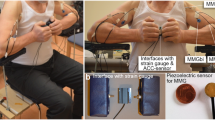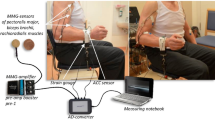Abstract
Objectives
The relation between increase of tonus and joint movement velocity is controversial in Parkinson’s rigidity. It is accepted that the increase of tonus in rigidity is constant during joint movement, and does not change within all limits of movement. However, there is thoughtful evidence that the change in tonus in rigidity has a correlation with joint movement velocity and amplitude of movement. The pendulum movement that is formed by triggering of the patellar T reflex allows the examination of phasic stretching reflexes and physiological changes of passive stretching. Therefore, the velocity and amplitude properties of tonus in Parkinson’s rigidity can be scanned together.
Materials and methods
Patellar T reflex-triggered patellar pendulum was recorded in 40 Parkinson’s patients. The velocity and amplitude changes in the pendulum were observed according to the rigidity scale. Muscle action potentials were recorded from the rectus femoris muscle and biceps femoris muscles simultaneously via superficial recording electrodes. Knee joint angle changes were recorded with a goniometer. The kinesiological and electromyographic features were compared with those of the control subjects.
Results
The number of pendulums decreased significantly, the angle of joint movement decreased, the peak time decreased and the angular velocity slowed down significantly in the Parkinson’s group. While the latency of the patellar T reflex did not change significantly, its amplitude decreased, and the onset time of joint movement measured by accelerometer was prolonged.
Conclusions
Parkinson’s rigidity has a velocity-dependent component, and this correlates negatively with the rigidity scale.




Similar content being viewed by others
References
Jankovic J (2008) Parkinson’s disease: clinical features and diagnosis. J Neurol Neurosurg Psychiatry 79(4):368–376. https://doi.org/10.1136/jnnp.2007.131045
Samii A, Nutt JG, Ransom BR (2004) Parkinson’s disease. Lancet 363(9423):1783–1793. https://doi.org/10.1016/S0140-6736(04)16305-8
Schrag A (2007) Epidemiology of movement disorders. In: Tolosa EaJ JJ (ed) Parkinson's disease and movement disorders. Lippincott Williams & Wilkins, Hagerstown, pp 50–66
Fung VT, PD. (2002) Rigidity and spasticity. In: Jankovic ET JJ (ed) Parkinson’s disease and movement disorders, 4th edn. Lippincott Williams& Wilkins, Philadelphia, pp 473–482
Powell D, Threlkeld AJ, Fang X, Muthumani A, Xia R (2012) Amplitude- and velocity-dependency of rigidity measured at the wrist in Parkinson’s disease. Clin Neurophysiol 123(4):764–773. https://doi.org/10.1016/j.clinph.2011.08.004
Rothwell JC, Obeso JA, Traub MM, Marsden CD (1983) The behaviour of the long-latency stretch reflex in patients with Parkinson’s disease. J Neurol Neurosurg Psychiatry 46(1):35–44. https://doi.org/10.1136/jnnp.46.1.35
Delwaide PJ, Sabbatino M, Delwaide C (1986) Some pathophysiological aspects of the parkinsonian rigidity. J Neural Transm Suppl 22:129–139
Bergui M, Dimanico U, Paglia G, Quattrocolo G, Troni W, Bergamini L (1992) Stretch reflex of quadriceps femoris in normal man: methodological considerations and normative data. Electromyogr Clin Neurophysiol 32(12):597–601
Meara RJ, Cody FW (1993) Stretch reflexes of individual parkinsonian patients studied during changes in clinical rigidity following medication. Electroencephalogr Clin Neurophysiol 89(4):261–268. https://doi.org/10.1016/0168-5597(93)90105-x
Tatton WG, Bedingham W, Verrier MC, Blair RD (1984) Characteristic alterations in responses to imposed wrist displacements in parkinsonian rigidity and dystonia musculorum deformans. Can J Neurol Sci 11(2):281–287. https://doi.org/10.1017/s0317167100045546
Tatton WG, Eastman MJ, Bedingham W, Verrier MC, Bruce IC (1984) Defective utilization of sensory input as the basis for bradykinesia, rigidity and decreased movement repertoire in Parkinson’s disease: a hypothesis. Can J Neurol Sci 11(1 Suppl):136–143. https://doi.org/10.1017/s0317167100046291
Cody FW, MacDermott N, Matthews PB, Richardson HC (1986) Observations on the genesis of the stretch reflex in Parkinson’s disease. Brain 109(Pt 2):229–249. https://doi.org/10.1093/brain/109.2.229
Burke D, Gillies JD, Lance JW (1970) The quadriceps stretch reflex in human spasticity. J Neurol Neurosurg Psychiatry 33(2):216–223. https://doi.org/10.1136/jnnp.33.2.216
Voerman GE, Gregoric M, Hermens HJ (2005) Neurophysiological methods for the assessment of spasticity: the Hoffmann reflex, the tendon reflex, and the stretch reflex. Disabil Rehabil 27(1–2):33–68
Uysal H, Mogyoros I, Burke D (1999) Reproducibility of tendon jerk reflexes during a voluntary contraction. Clin Neurophysiol 110(8):1481–1487
Burke D, Knowles L, Andrews C, Ashby P (1972) Spasticity, decerebrate rigidity and the clasp-knife phenomenon: an experimental study in the cat. Brain 95(1):31–48. https://doi.org/10.1093/brain/95.1.31
Burke D, Andrews CJ, Lance JW (1972) Tonic vibration reflex in spasticity, Parkinson’s disease, and normal subjects. J Neurol Neurosurg Psychiatry 35(4):477–486. https://doi.org/10.1136/jnnp.35.4.477
Dietrichson P (1971) Tonic ankle reflex in parkinsonian rigidity and in spasticity. The role of the fusimotor system. Acta Neurol Scand 47(2):163–182. https://doi.org/10.1111/j.1600-0404.1971.tb07474.x
Lance JB, D.; Andrews, CJ. (1973) The reflex effects of muscle vibration. In: JED (ed) new developments in electromyography and clinical neurophysiology, vol 3. Basel, Karger, pp 44–462
Gurbuz M, Bilgin S, Albayrak Y, Kizilay F, Uysal H (2015) Biceps femoris late latency responses and the “notching sign” in spasticity. J Neuroeng Rehabil 12:93. https://doi.org/10.1186/s12984-015-0084-7
Goetz CG, Fahn S, Martinez-Martin P, Poewe W, Sampaio C, Stebbins GT, Stern MB, Tilley BC, Dodel R, Dubois B, Holloway R, Jankovic J, Kulisevsky J, Lang AE, Lees A, Leurgans S, LeWitt PA, Nyenhuis D, Olanow CW, Rascol O, Schrag A, Teresi JA, Van Hilten JJ, LaPelle N (2007) Movement Disorder Society-sponsored revision of the Unified Parkinson’s Disease Rating Scale (MDS-UPDRS): process, format, and clinimetric testing plan. Mov Disord 22(1):41–47. https://doi.org/10.1002/mds.21198
Goetz CG, Poewe W, Rascol O, Sampaio C, Stebbins GT, Counsell C, Giladi N, Holloway RG, Moore CG, Wenning GK, Yahr MD, Seidl L, Movement Disorder Society Task Force on Rating Scales for Parkinson's D (2004) Movement Disorder Society Task Force report on the Hoehn and Yahr staging scale: status and recommendations. Mov Disord 19(9):1020–1028. https://doi.org/10.1002/mds.20213
Uslu S, Nuzket T, Albayrak Y, Uysal H (2016) Evaluation of the patellar tendon reflex with reflex hammer that can measure impact force, muscle vibration and CMAP. J Neurol Sci-Turk 33(2):214–226
Uslu SNT, Uysal H (2018) Modified motor unit number index (MUNIX) algorithm for assessing excitability of alpha motor neuron in spasticity. Clin Neurophysiol Pract 3:127–133
Brown RA, Lawson DA, Leslie GC, Part NJ (1988) Observations on the applicability of the Wartenberg pendulum test to healthy, elderly subjects. J Neurol Neurosurg Psychiatry 51(9):1171–1177. https://doi.org/10.1136/jnnp.51.9.1171
Brown RA, Lawson DA, Leslie GC, MacArthur A, MacLennan WJ, McMurdo ME, Mutch WJ, Part NJ (1988) Does the Wartenberg pendulum test differentiate quantitatively between spasticity and rigidity? A study in elderly stroke and Parkinsonian patients. J Neurol Neurosurg Psychiatry 51(9):1178–1186. https://doi.org/10.1136/jnnp.51.9.1178
Andrews CJ, Burke D, Lance JW (1972) The response to muscle stretch and shortening in Parkinsonian rigidity. Brain 95(4):795–812. https://doi.org/10.1093/brain/95.4.795
Berardelli A, Sabra AF, Hallett M (1983) Physiological mechanisms of rigidity in Parkinson’s disease. J Neurol Neurosurg Psychiatry 46(1):45–53. https://doi.org/10.1136/jnnp.46.1.45
Xia R, Rymer WZ (2004) The role of shortening reaction in mediating rigidity in Parkinson’s disease. Exp Brain Res 156(4):524–528. https://doi.org/10.1007/s00221-004-1919-9
Pierrot-Deseilligny E, Burke D (2005) The circuitry of the human spinal cord. Its role in motor control and movement disorders. Cambridge University Press
Fahn SE, Elton RL (1987) Unified Parkinson’s disease rating scale. Recent Developments in Parkinson’s Disease. Macmillan Health Care Information, Florham Park
Simonetta Moreau M, Meunier S, Vidailhet M, Pol S, Galitzky M, Rascol O (2002) Transmission of group II heteronymous pathways is enhanced in rigid lower limb of de novo patients with Parkinson’s disease. Brain 125(Pt 9):2125–2133. https://doi.org/10.1093/brain/awf201
Lee RG (1989) Pathophysiology of rigidity and akinesia in Parkinson’s disease. Eur Neurol 29(Suppl 1):13–18. https://doi.org/10.1159/000116448
Lee RGT, W.G. (1978) Long loop reflexes in man: clinical applications. In: Cerebral Motor Control in Man: Long Loop Mechanisms, Progress in Clinical Neurophysiology, vol 4. Karger, Basel
Kushnir M, Klein C, Rabey JM (2001) H reflex behavior in Parkinson’s disease patients and patients with extrapyramidal and pyramidal signs combined. J Neurol Sci 186(1–2):101–105. https://doi.org/10.1016/s0022-510x(01)00511-1
Sabbahi M, Etnyre B, Al-Jawayed I, Jankovic J (2002) H-reflex recovery curves differentiate essential tremor, Parkinson’s disease, and the combination of essential tremor and Parkinson’s disease. J Clin Neurophysiol 19(3):245–251
Sabbahi M, Etnyre B, Al-Jawayed IA, Hasson S, Jankovic J (2002) Methods of H-reflex evaluation in the early stages of Parkinson’s disease. J Clin Neurophysiol 19(1):67–72
Acknowledgments
We would like to thank Ms. Barbara for making the English revisions of the article in her native language. We thank the patients for their cooperation.
Funding
The study was supported by the Scientific and Technological Research Council of Turkey Grant (grant number: 214 S 175).
Author information
Authors and Affiliations
Contributions
(1) Research project: A. conception, B. organization and C. execution
(2) Statistical analysis: A. design, B. execution and C. review and critique
(3) Manuscript: A. writing of the first draft, B. review and critique and C. writing major reviews
S.U: 1C, 2A, 2B, 3A, 3B
MG: 1B, 1C, 3C
F.K: 1B, 3B
S.Ö: 1B, 2C, 3B
T.N.:1B, 1C, 2B, 3B
H.U: 1A, 1B, 1C, 2A, 2C, 3A, 3C
Corresponding author
Ethics declarations
Conflict of interest
The authors declare that they have no conflict of interest.
Ethical approval
None.
Additional information
Publisher’s note
Springer Nature remains neutral with regard to jurisdictional claims in published maps and institutional affiliations.
Rights and permissions
About this article
Cite this article
Uslu, S., Gürbüz, M., Kızılay, F. et al. Amplitude and velocity dependence of patellar pendulum triggered by T reflex in Parkinson’s rigidity. Neurol Sci 42, 3257–3266 (2021). https://doi.org/10.1007/s10072-020-04936-y
Received:
Accepted:
Published:
Issue Date:
DOI: https://doi.org/10.1007/s10072-020-04936-y




